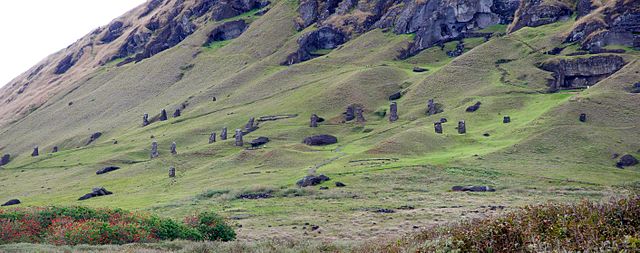Moai or moʻai are monolithic human figures carved by the Rapa Nui people on Rapa Nui in eastern Polynesia between the years 1250 and 1500. Nearly half are still at Rano Raraku, the main moai quarry, but hundreds were transported from there and set on stone platforms called ahu around the island's perimeter. Almost all moai have overly large heads, which account for three-eighths of the size of the whole statue. They also have no legs. The moai are chiefly the living faces of deified ancestors.
Moai facing inland at Ahu Tongariki, restored by Chilean archaeologist Claudio Cristino in the 1990s
Moai set in the hillside at Rano Raraku
Moʻai quarry at Rano Raraku
Re-erected tuff moai at Ahu Tahai with restored pukao and replica eyes
The Rapa Nui are the indigenous Polynesian peoples of Easter Island. The easternmost Polynesian culture, the descendants of the original people of Easter Island make up about 60% of the current Easter Island population and have a significant portion of their population residing in mainland Chile. They speak both the traditional Rapa Nui language and the primary language of Chile, Spanish. At the 2017 census there were 7,750 island inhabitants—almost all living in the village of Hanga Roa on the sheltered west coast.
Traditional dance of Rapa Nui people
Group of Rapa Nui people at Hanga Roa, c. 1914
Juan Tepano Rano ʻa Veri ʻAmo, a full-blood Rapa Nui and Chilean military officer, while serving in the 1915 Mana Expedition (23 July 1915).
Image: Easter Island Man








